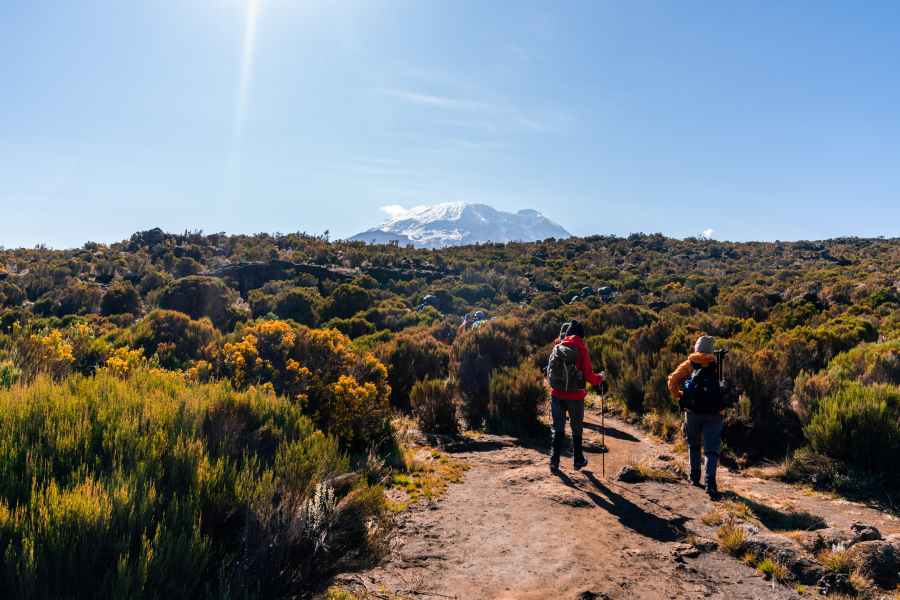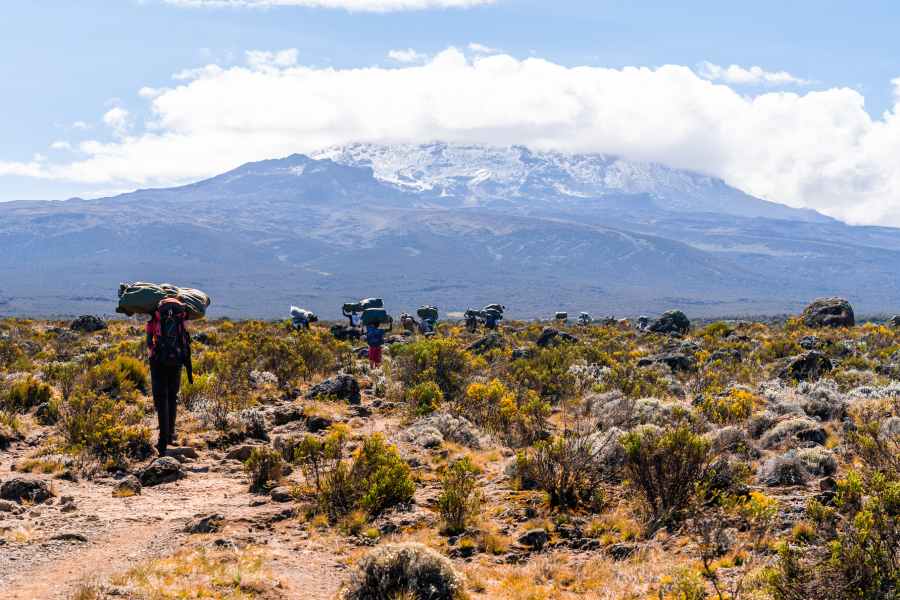Phenomenal Hikes To Mount Kilimanjaro’s Summit
Download Travel Details >PRIVATE & SMALL GROUP TOURS TO THE WORLD'S BEST DESTINATIONS
Join Us For A Safari In Tanzania

How Long Does It Take To Hike Mount Kilimanjaro?
High above the African bushlands of Tanzania and Kenya sits Mount Kilimanjaro, Africa’s highest peak and a bucket list destination for avid hikers. Of the mountain’s three volcanic cones – Kibo, Maesnzi, and Shira – it’s Kibo that rises to the highest point in Africa, extending toward the sky until it ends at Uhuru Peak at 19,340 feet above sea level. But just how many miles is Kilimanjaro’s route to the top, and how long does it take to get there?
Following the first expedition to Kilimanjaro in 1889, the mountain has become a major climbing destination for adventurers worldwide, prompting its designation as a protected resource within Kilimanjaro National Park. Today, hikers must hire a guide and join an official Mount Kilimanjaro climbing tour in order to access Kil’s summit. However, the number of miles to Uhuru Peak varies according to the route you pick, as does the length of time it takes to summit Mount Kilimanjaro.

Choose Your Own Adventure: Kilimanjaro’s Many Routes
The first question hikers ask before they plan their climb up Kili is, “How long does it take to hike Mount Kilimanjaro?” There is no easy answer to this question because the answer depends on the route your guide selects and how many breaks you build into the trek in order to keep altitude sickness to a minimum. Other hikers ask, “How many miles is the Kilimanjaro climb?” Again, the answer depends on the route you take! The shortest route is Umbwe, which is also the steepest, measuring 23 miles. The longest route is the Northern Circuit, which allows hikers more time for acclimatization and measures 56 miles.
How Long Does Each Route Take?
There are a total of seven different routes you can use to climb Mount Kilimanjaro. The shortest possible way to the summit is by the Marangu or the Umbwe Route. These routes can be completed in 5 days. However, the shorter the route, the higher the probability of failure due to altitude sickness! The longer routes – Lemosho, Machame, Rongai, or the Northern Circuit – take six to ten days.
The main reason you want to take a longer Mount Kilimanjaro climbing tour is to give your body time to acclimatize to the altitude, but there are other considerations as well. Fitness level is important for a successful summit. Unless you are very fit, covering a long distance in a shorter time frame can increase your chances of fatigue and injury, while diminishing your ability to enjoy your surroundings!
Your guide should be able to suggest a route based on your fitness and hiking ability. For a list of each route and the distance to Kili’s summit, please see below.
- Marangu Route – this route should take hikers five days to complete while covering 40 miles.
- Umbwe Route – this route should take hikers six days to complete while covering 23 miles. It is the steepest and most difficult route and should be attempted only by experienced trekkers.
- Rongai Route – this route will take six or seven days to complete and covers 23 miles.
- Machame Route – this route will take six or seven days to complete and covers 30 miles.
- Lemosho Route – this route can take anywhere between seven and nine days to complete and covers 35 miles.
- Northern Circuit – this route takes 8 or 9 days to complete and covers 35 miles.
- Shira Route: this route starts from a higher elevation and covers 27 to 32 miles. It allows hikers to spend some time at their base camp getting used to the thinner mountain air.
How To Plan A Successful Summit
 Trekkers who choose a shorter route have the lowest summit success rate. Those who spend eight or nine days before attempting the final summit have a much better chance of achieving their goal! Kilimanjaro is considered a walk-up mountain, meaning there is no technical climbing involved. However, its summit rate is very low. The main reason climbers fail to reach the summit is simply because they have not acclimatized to the altitude.
Trekkers who choose a shorter route have the lowest summit success rate. Those who spend eight or nine days before attempting the final summit have a much better chance of achieving their goal! Kilimanjaro is considered a walk-up mountain, meaning there is no technical climbing involved. However, its summit rate is very low. The main reason climbers fail to reach the summit is simply because they have not acclimatized to the altitude.
If you are serious about completing the climb to Kili’s summit, the guide you choose can be critical to your success. Joining a Mount Kilimanjaro climbing tour with a guide who knows that going slow and taking your time will allow your body to gradually adapt to the lack of oxygen is the key to a successful summit! The more days you spend on the mountain acclimatizing, the better your chances of reaching the top.
5 Key Tips For Reaching The Summit
Reaching Kili’s summit takes more than being physically fit (although that’s a great starting point!). Here are five simple, practical tips that you can use to help boost your chances of reaching the top of Mount Kilimanjaro.
- Spend as many days on the mountain as possible. Being physically fit is important, but when it comes to hiking at high altitudes, being acclimatized has a greater impact on your chances of summiting than anything else. In order to avoid acute mountain sickness, or AMS, climbing slowly and steadily is important. This is the single most important thing you can do to improve your chances of a successful summit!
- Prioritize getting enough sleep. Believe it or not, a common side effect of altitude is trouble sleeping. So you should make sure you have a plan to help you get enough sleep on the trail. Bring an eye mask or earplugs for daytime naps, or practice evening meditation routines before your hike to get in the habit of relaxing before bedtime.
- Go slow. High-altitude trekking is much more difficult than hiking at sea level. To climb Mount Kilimanjaro, it is important to go slow and allow your body time to acclimatize to altitude. This will minimize your chances of getting sick, too!
- Drink as much water as possible. Acclimatization is usually accompanied by fluid loss, so it is important to drink at least three to four quarts of water per day as you climb. Proper hydration will better aid your acclimatization and help you reach the summit!
- Book reliable guides – even if it costs more. To climb Kilimanjaro, you are legally required by Tanzanian law to have a mountain crew with you. This can be expensive, but booking a cheap tour operator can make the climb miserable. It is better to contract with a reputable operator and knowledgeable crew, which will make your experience successful and memorable.
On Top Of The World
How long does it take to hike Mount Kilimanjaro? Well, that depends on you! The short answer is anywhere between five and nine days, but the longer answer depends on your fitness level and the recommendation of your guide. Just remember, the more days you spend on the mountain, the better your chances of reaching the summit. So, lace up those hiking boots and get going! Adventure awaits.

